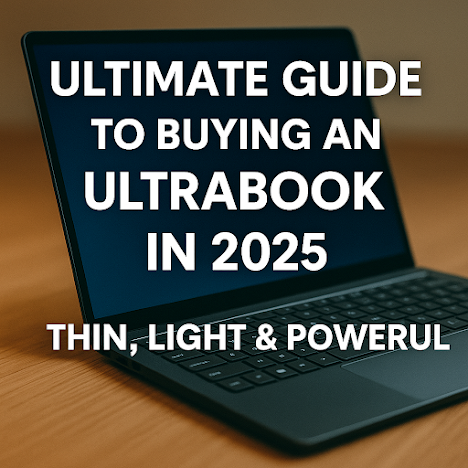Picture this: you’re sipping coffee at a bustling café, juggling spreadsheets, video calls, and a creative project—all on a sleek laptop that barely tips the scales. This isn’t sci-fi; it’s the reality of 2025’s ultrabooks. As CES 2025 showcased, the line between portability and power has blurred, with innovations like AI-driven processors, sustainable designs, and OLED displays redefining what a laptop can be. Whether you’re a digital nomad, a student, or a professional seeking peak performance, this guide will help you navigate the thin, light, and powerful world of ultrabooks.
What Defines an Ultrabook in 2025?Gone are the days when "ultrabook" simply meant "thin." Today’s models blend cutting-edge engineering with purposeful innovation. Let’s break down the essentials:
Key Features to Prioritize
Portability: Under 3 lbs and ≤0.7 inches thick.
Battery Life: Aim for 15+ hours (e.g., Asus Zenbook 14 OLED lasts 19.5 hours ).
Display: OLED panels dominate for vibrant colors (e.g., Lenovo Yoga 9i’s 2880x1800 OLED ).
Performance: AI-ready CPUs like Intel Core Ultra or AMD Ryzen AI 300-series.
Sustainability: Recycled materials and repairability (e.g., Framework Laptop’s modular design ).
CES 2025’s Ultrabook Innovations: What’s Hot
This year’s CES was a goldmine for laptop enthusiasts. Here’s what stood out:
1. AI Everywhere
Intel’s Lunar Lake and AMD’s Ryzen AI 300 chips now handle on-device AI tasks like real-time photo editing and voice commands. The HP OmniBook Ultra Flip, for example, uses AI to optimize battery life and performance .
2. OLED Displays Go Mainstream
From Asus’ Zenbook A14 to Lenovo’s ThinkPad X9, OLED screens with 120Hz refresh rates are now standard, offering deeper blacks and energy efficiency.
3. Sustainability Takes Center Stage
Brands like Asus and HP are using ocean-bound plastics and 100% recyclable packaging. The Framework Laptop 13 even lets you swap out components to reduce e-waste.
4. Thinner Designs, Cooler Tech
MSI’s Raider 18 HX AI packs a 5090 GPU into a 0.59-inch chassis, while Razer’s Blade 16 is their thinnest ever—proof that gaming and ultraportability can coexist.
Top 5 Ultrabooks of 2025: CES Standouts
Based on hands-on reviews and specs, here are the year’s best:
| Model | Key Features | Battery Life | Weight | Price |
|---|---|---|---|---|
| Asus Zenbook 14 OLED | AMD Ryzen 7 8840HS, 19.5h battery, 2.82 lbs | 19h 56m | 2.82 lbs | $1,249 |
| Lenovo ThinkPad X9 | Intel Core Ultra 7, 32GB RAM, 0.59” thickness | 13h | 2.47 lbs | $1,399 |
| HP OmniBook Ultra Flip | Lunar Lake CPU, 21h battery, 2.97 lbs | 21h | 2.97 lbs | $1,799 |
| Framework Laptop 13 | Upgradable design, 13.5” 2256x1504 display | 13h | 2.9 lbs | $899 |
| MacBook Air M4 | Apple M4 chip, 18h battery, fanless design | 18h | 2.7 lbs | $976 |
Why These Shine:
Zenbook 14 OLED: Best value with a stunning display and marathon battery.
ThinkPad X9: Business-ready with a MacBook-rivaling design.
OmniBook Ultra Flip: AI-powered efficiency for creatives.
How to Choose: 5 Questions to Ask
“Do I need AI features?” If you edit media or use Copilot+, opt for Intel Core Ultra or Ryzen AI chips.
“How mobile am I?” Students should prioritize sub-3-pound models like the Acer Swift Go 14.
“Is repairability important?” Framework’s modular design saves long-term costs.
“What’s my budget?” Under $1,000? Consider the Dell Inspiron 14 Plus.
“Do I need a 2-in-1?” Lenovo Yoga 9i’s rotating hinge is perfect for artists.
Where to Buy: Deals & Affiliate Picks
For budget-friendly options, check these AliExpress picks:
ASUS Vivobook S 14: Lightweight with OLED touchscreen.
Lenovo IdeaPad Slim 5: Great for students.
HP Pavilion Aero: Under 2.2 lbs with Ryzen 7.
Final Thoughts: The Future Is Ultra
2025’s ultrabooks aren’t just tools—they’re statements. With AI enhancing productivity, OLEDs dazzling the eyes, and sustainability becoming non-negotiable, there’s never been a better time to upgrade. Whether you’re drawn to the Zenbook’s battery life or the Framework’s eco-friendly ethos, your perfect match is out there.

